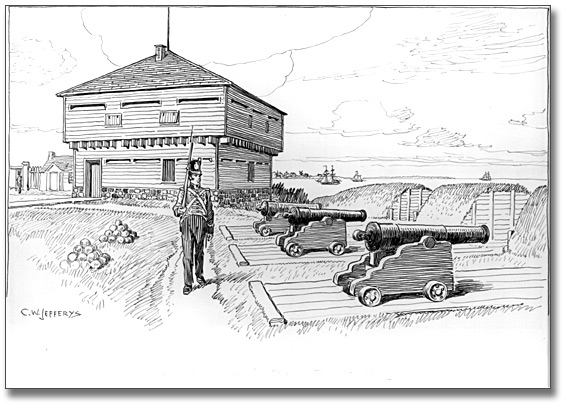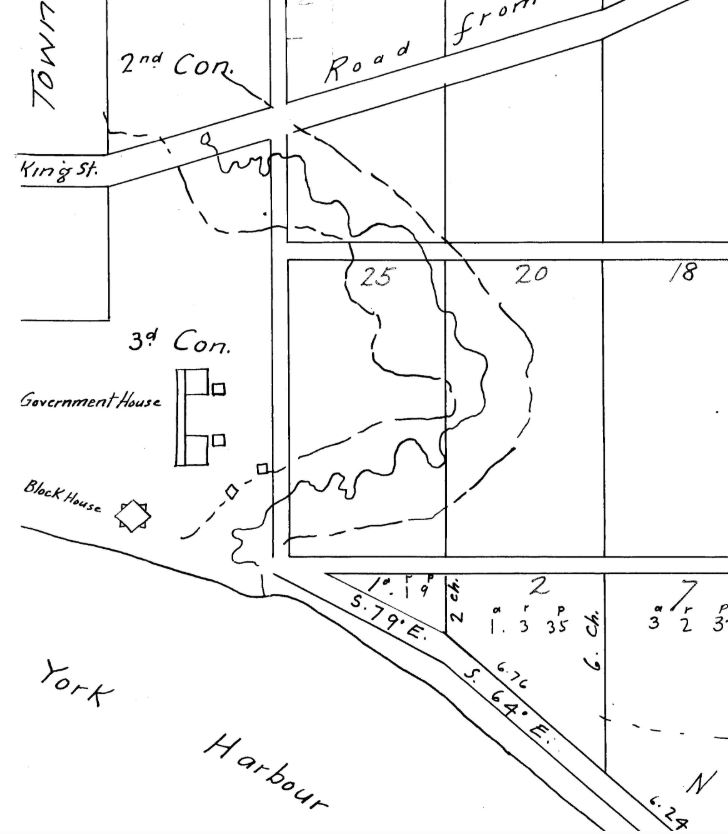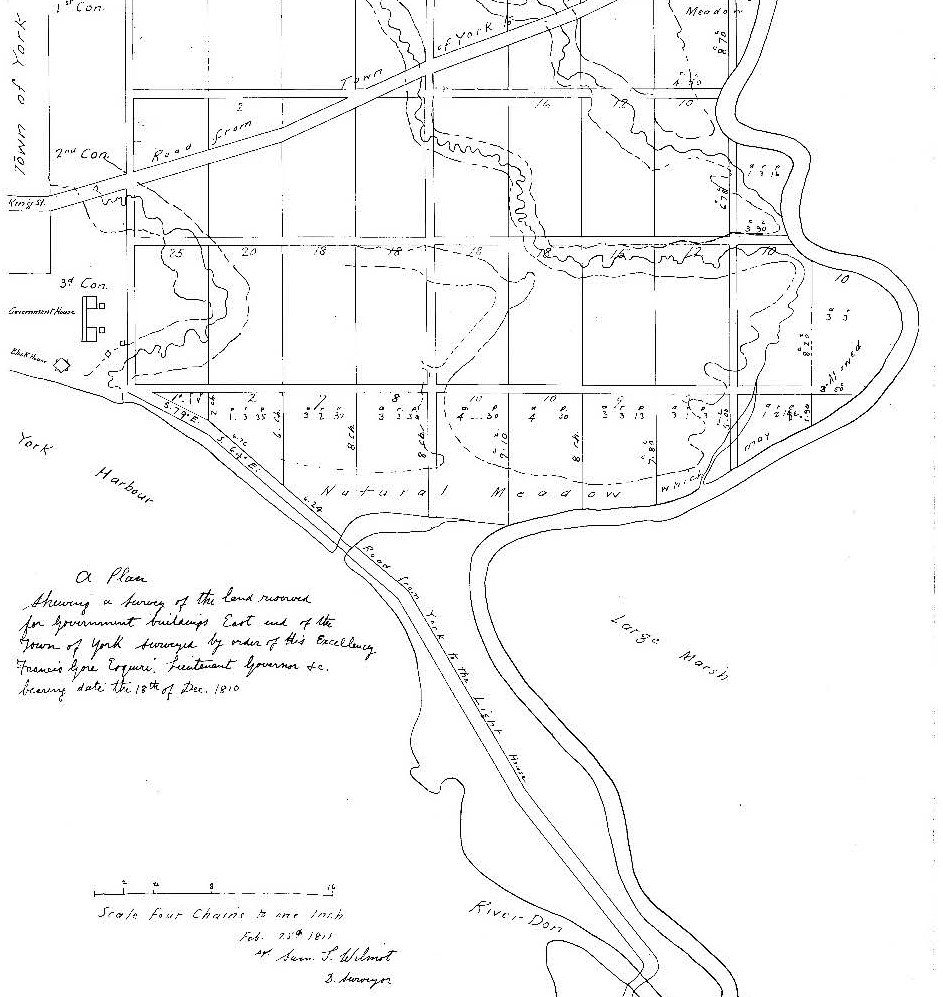A Forgotten Blockhouse Revealed: York’s Pre-1812 Defenses

Sometimes, exploring historic surveys requires a bit of detective work. You find something interesting, look for information, follow signs, hit a dead end, and eventually you uncover a small detail that flips a switch in your brain, like someone just turned the light on upstairs.
|
Recently, I came across a survey from 1810 that instantly piqued my curiosity when I saw a small black square labeled “blockhouse”, south of King Street, near the area that would eventually become Parliament and the Esplanade. My initial research led me to information about Blockhouses located within Fort York or built after the Rebellion of 1837. There was no mention of the blockhouse in question, leading me to believe that this plan may have been abandoned.
|
 |
What Was the Town Blockhouse?
According to this article, York (now Toronto) built several blockhouses in the 1790s, well before the more notable ones built in the War of 1812 and the 1837 Rebellion. One specific blockhouse was referred to as the “Town Blockhouse”, which was constructed in 1798 within the early settlement of York and roughly two kilometers east of Fort York. The location of this Blockhouse is similar to the blockhouse shown in the 1810 survey plan, just west of the Don River.
The Town Blockhouse had a unique role, serving as a guardhouse and gathering point for military personnel. It had a kitchen, allowing it to also function as a barracks for housing soldiers. The construction of this Town Blockhouse was partly driven by a conflict with the local Mississauga people in the years previous.
Early Strategic Defences
Whether or not this blockhouse is the blockhouse in our survey, the presence of it on a government-issued survey demonstrates that authorities in York were thinking strategically well before the War of 1812. John Graves Simcoe, York’s founding governor, had envisioned a system of many blockhouses to protect against threats from the Americans across the lake. Unfortunately, financial constraints limited his plans, and many were never built.
When the Americans invaded in 1813, the few blockhouses that existed proved insufficient in battle, and several of them were burned to the ground during the attack. Their existence was largely overshadowed by later historical and more well-documented events.
Blockhouse No. 1 (1838)
In 1838, a more famous blockhouse was built at the foot of Parliament Street, “Blockhouse No. 1”. In response to the 1837 Rebellion, this structure was built as part of a broader plan to protect Toronto against both internal and external threats. With the evidence that a blockhouse had previously been built near this location, it seems possible that this new 1838 blockhouse was not built on entirely new ground but was perhaps the rebuilding of an existing defensive post. If this location was considered a critical point of defense in the past, it would likely remain so in the following years.
Why This Matters
Historic Surveys such as this one often trigger questions. The research can take you down many paths and often brings about many more questions. Exploring history in this way forces us to revisit an integral part of York’s history and the defences that quietly marked the town's eastern edge.
This is a great reminder of how quickly history can be forgotten, and without well-documented records, such as this 1810 survey, the Town Blockhouse of 1798 could have been forgotten.
Present Day Toronto
Fast forward two hundred years, and this area at the base of Parliament bears no resemblance to the defensive post that it once served as. Today, this urban space in the St. Lawrence neighbourhood is filled with modern condo buildings, restaurants, and parks. Next time you are in the area, keep in mind that you’re walking on the land that once served as a fortification site, and a place where the future of York, and the country that would become Canada, was once uncertain.

References
1. Benn, Carl. "The Blockhouses of Toronto: A Material History Study." Material Culture Review 37, no. 1 (1993).
https://journals.lib.unb.ca/index.php/mcr/article/view/17655/22305
2. Benn, Carl. "On the Many Sketches of Toronto Blockhouses." Fort York National Historic Site.
https://www.fortyork.ca/newsletter-subscription/27-resources/management-docs/67-on-the-many-sketches-of-toronto-blockhouses.html
3. "Battle of York." Wikipedia.
https://en.wikipedia.org/wiki/Battle_of_York.
4. Toronto Public Library, Digital Archive Ontario.
https://digitalarchiveontario.ca.
5. Library and Archives Canada. "York Blockhouse." Advanced Search, Collection Search.
https://recherche-collection-search.bac-lac.gc.ca/eng/Home/Result?q_type_1=q&q_1=York+Blockhouse&SEARCH_TYPE=SEARCH_ADVANCED&num=25&start=0&enviro=prod&DateBucket=1800-1809.
6. Archives of Ontario. "Soldier Life." The War of 1812 Online Exhibit.
https://www.archives.gov.on.ca/en/explore/online/1812/soldier-life.aspx.
7. Archives of Ontario. "Niagara and York, 1813." The War of 1812 Online Exhibit.
https://www.archives.gov.on.ca/en/explore/online/1812/niagara-1813.aspx.
8. Wilmot, Samuel (Deputy Surveyor). A Plan Shewing the Survey of the Land Reserved for Government Buildings, East End of the Town of York, December 1810. Protect Your Boundaries Digital Archive.
https://protectyourboundaries.ca.
9. Archives of Ontario. Plan of Fort York and Vicinity, ca. 1816. Government of Ontario, https://www.archives.gov.on.ca/en/explore/online/1812/big/big_062_fort_york.aspx. Accessed 16 July 2025












